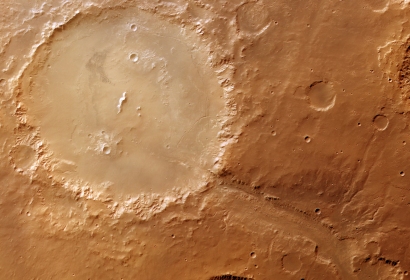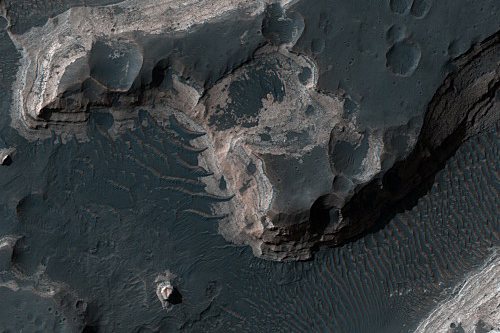So in a recent column I told you all the problems with having water on Mars in recent history -- namely that the atmosphere is too thin to have supported it. But many of you have (rightly) pointed out to me that there is some evidence that there could have been water on Mars a very long time ago, and that would explain some of the major features on Mars.
But one problem that remained is this: where are the carbonate deposits at the bottoms of these so called streambeds or dried-up lakes? Well, over the weekend I got an interesting email from National Geographic Magazine about Holden Crater on Mars, asking for my comments about Mars' wet past in general.

Here's what I said,
Mars may have had water once, but if it did, it was certainly many billions of years ago (maybe 3 billion years ago is a conservative estimate). Because Mars' atmosphere is so thin, it doesn't support liquid water; from what we can tell, the pressure is so low that any water on Mars goes straight from solid ice to water vapor. The atmosphere has certainly been that thin for the last couple of billion years. But if the atmosphere was much thicker a long time ago in the past, there could have been pools of liquid water that formed. There is some evidence that there was water, like the meanders of what look like streambeds, and some evidence that there wasn't water, like the lack of carbonate deposits in those so-called streambeds. The jury's still out, but if we could, for instance, dig up a piece of those deposits and were able to find stratified sedimentary rock, that would certainly be strong evidence for a past history of water. (You will be able to find a large number of people who are more optimistic than I am about a wet past for Mars.)
And then they wrote back to me and told me a little more about the discovery. Apparently, Mars HiRISE looks like it's found those sedimentary deposits that I was talking about at the bottom of this crater: there are layers of clay! So it's possible that an event happened, exposing the deposits that have supposedly been buried by dirt and dust over the time that Mars has been dry since then! Take a look at the layers below, formed an estimated 3.7 billion years ago:

The next generation of Mars rovers are slated to explore Holden crater as one of their stops, so we'll have a much more definite answer as to what went on there. So I then wrote and said
The geophysical community pretty much accepts that there was water on Mars, but where, when, and how much are open for debate. Additionally, as you state, there are a number of questions that are largely unanswered.
The thing that's interesting about this crater is that the deposits which aren't found in the Martian streambeds are, presumably, found here in the crater. (That's what the clay is.) And that, indeed may go a long way towards providing more evidence for a wet past on Mars.
Isn't it cool how overstating my case, rather than coming back to bite me, actually has provided me with the opportunity to learn something? In any case, my new conclusions about Mars: dry present, dry recent past, but looking more and more like a wet ancient history. Let's see what the next generation of rovers have to say!

Actually the reason that Mars has such a thin atmosphere is that 4 Billion years ago it lost its magnetosphere, which inevitably damaged and made thinner, the atmosphere.
As for water. Yes. There is currently forms (none liquid) of water on Mars. At its polar caps as ice/snow clouds. Also, in the summer on mars the temperature rises to 20 degrees Celsius which proves that at least in the summer, life could live, temp-wise on mars. and clay found is a sign of definite water at one point, and of erosion.
Big bang started it all, but our universe, galaxy, etc, constantly moves outward... Which means Mars used to be at the same position, as Earth is now. Meaning it would have been similar to Earth.